Uncovering Petra
PeriBlog XVIII: Petra, Jordan
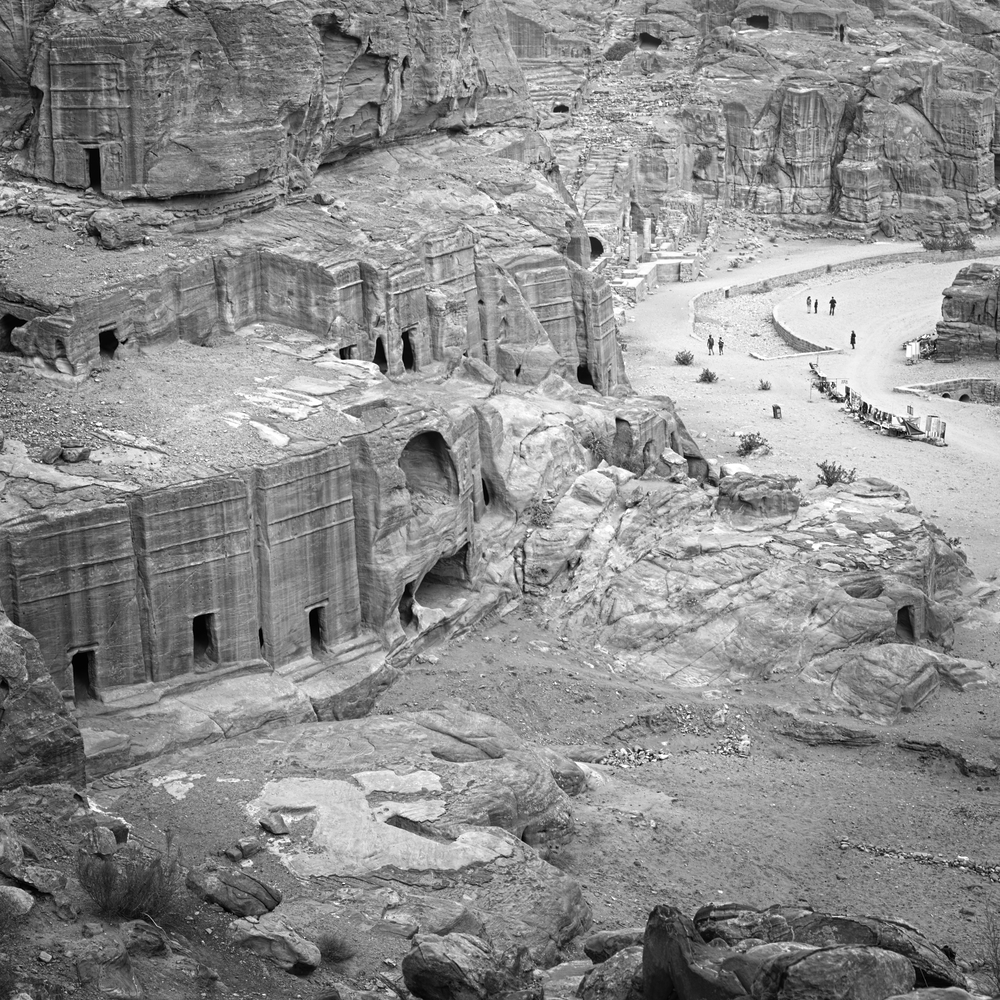
The great sandstone carvings of Petra, Jordan
You don’t hear much about the Nabataeans these days.
When people discuss ancient civilizations around the campfire, conversation inevitably gravitates toward the Greeks, the Romans, the Persians of Cyrus or the mysterious Tang Dynasty. We forget about the great cultures that flared around the rim of this eurocentric history—the Nabataeans receive little press coverage
But spend a few hours at Petra, and you will quickly discern the folly of that omission.
A visit to the Petra Museum
Actually, you could spend an hour in the Petra museum and emerge rather impressed. Through several well-designed exhibits, the museum (which doesn’t charge admission) provides a basic overview of the history and culture of the Nabataeans.
I would also like to point out, for the benefit of places like the Qumran Museum (see PeriBlog XVI), that the Petra Museum is exemplary in every way. Its excellent exhibits are educational and engaging; it displays real artifacts found on the site; and the gift shop is a small room, a slight fraction of the much larger exhibition space.
This is what a museum should look like.
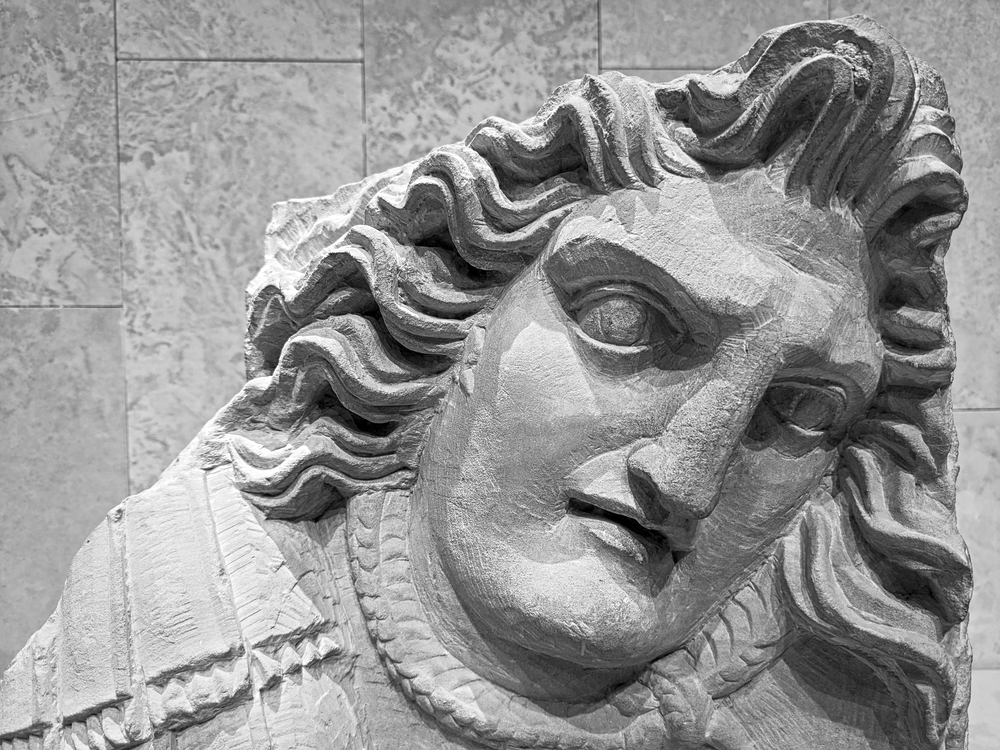
Medusa, from the Petra Museum
In addition to its superior price and design, the Petra Museum is also very informative. Exhibits offer useful summaries of the Nabataean age. The Nabataeans were originally Arabian nomads. They grew into a powerful trading empire, one that often competed with Israel. As time passed, the people transitioned toward settled life. Their greatest accomplishment was the construction of their capital city, Petra.
The Greek author Strabo devoted several chapters in his Geography to the Nabataeans and their accomplishments:
“The capital of the Nabatæans is called Petra. It is situated on a spot which is surrounded and fortified by a smooth and level rock (petra), which externally is abrupt and precipitous, but within there are abundant springs of water both for domestic purposes and for watering gardens. Beyond the enclosure the country is for the most part a desert, particularly towards Judaea” (Strabo, Geography, 16 [Perseus]).
This region’s unique topography allowed the Nabataeans to capture seasonal rain and store the water in sandstone cisterns. This reserve allowed the population of the city to weather the long dry months.
Into the domain of the Nabataeans
We visited the museum on the evening of our arrival, just before closing time. Even at that late hour it was humming. Outside, a steady surge of tourists were hiking out of the Petra entrance, bound for the many rows of tour buses parked behind the museum. Avoiding the crowds is always one of my primary ambitions, and an early start seemed like a sensible precaution. A quick consultation at the ticket window revealed that Petra’s gates opened at 6:00 a.m.
We set our alarm clock.
The next morning broke sunny and cool. Forsaking our free hotel breakfast, Mary and I joined the other early risers, and hiked into the site.
It is a 2.5 mile walk from the main entrance to the center of Petra. As we began our hike, I felt a sense of foreboding. The ancient city is described as one of the seven wonders of the ancient world. Had it been over-hyped? Could any place live up to its press clippings?
Petra does not disappoint. As we hiked along the main trail, sandstone cliffs rose around us. Like Wadi Rum, these surfaces have been water-twisted into startling, flowing shapes. We advanced through a narrowing canyon, and then suddenly it appears: the Treasury, one of the most iconic places in Petra.
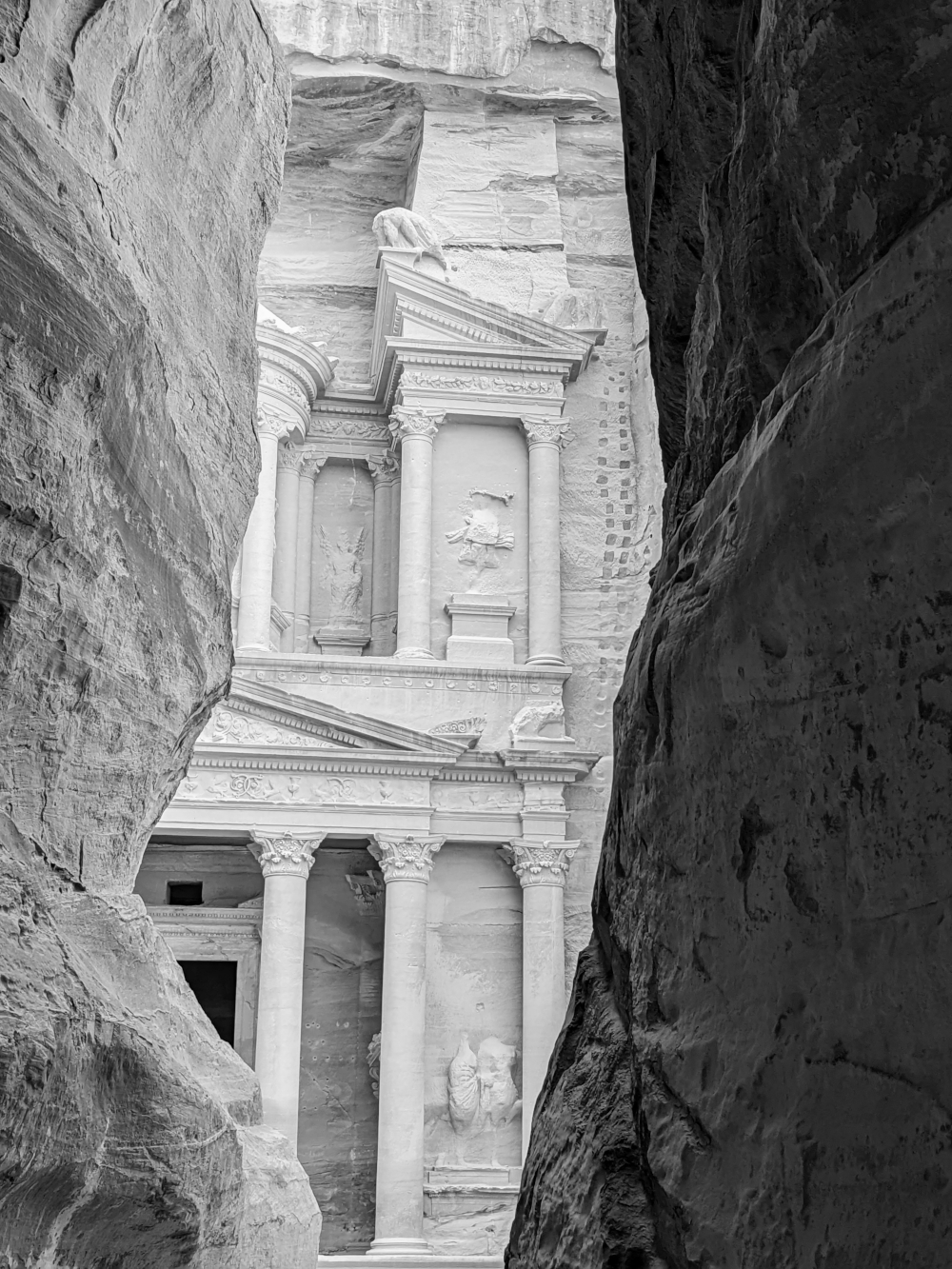
The Treasury
A monumental structure, carved into the sandstone, the Treasury stands seventy-nine feet wide and one hundred and twenty feet tall. It was carved to serve as the tomb for the Nabataean King Aretas IV. It never minted nor stored money—its name originates in an old Bedouin belief that treasure was hidden within its sandstone walls.
Continuing past the Treasury, we reached the junction with the High Place of Sacrifice Trail. As the name implies, this steep, winding path leads to to altars on the hilltops where sacrificial victims were once offered to the gods. There are also a couple of interesting obelisks, which baked beneath the strengthening Jordanian sun.
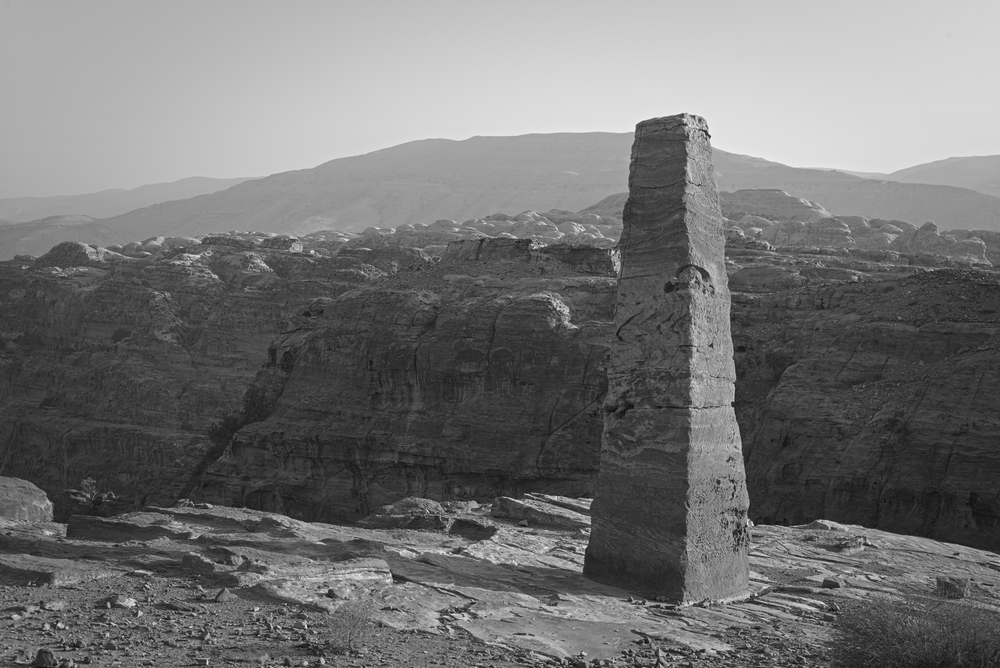
Obelisk at the High Place of Sacrifice
Descending the other side of the hill, we encountered a Petra cat. It shimmied down a cliff face to greet us, and then accompanied us as we switch-backed down a trail to the valley below.
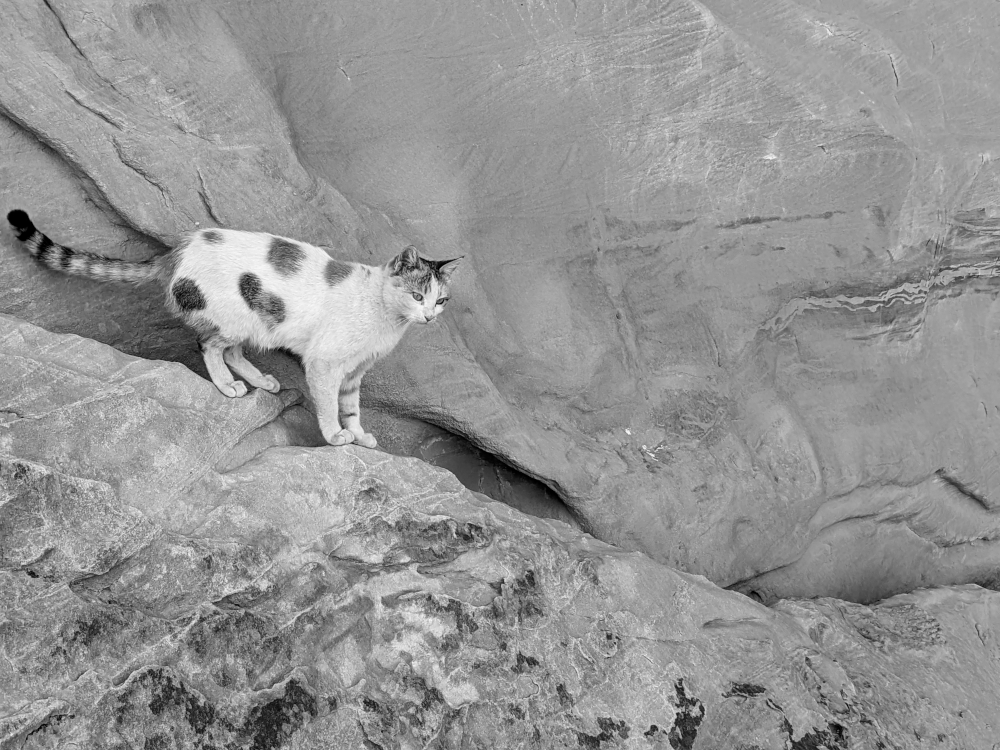
Spirit Cat
Our route had taken us off the beaten path. At the foot of the mountain we found an ancient tomb and a Triclinium. A Bedouin ran a shop within the walls of the temple. He offered us tea and coffee. Unlike Wadi Rum, these beverages came with a price tag.
Nevertheless, it was lovely to sit against the front facade of the temple, sip coffee, and talk to a local resident. Years ago all of his Bedouin family lived in the caves carved into the hills of Petra. Then the government built a village and most of the people moved out. Today only thirty-five families remain in the Petra caves.
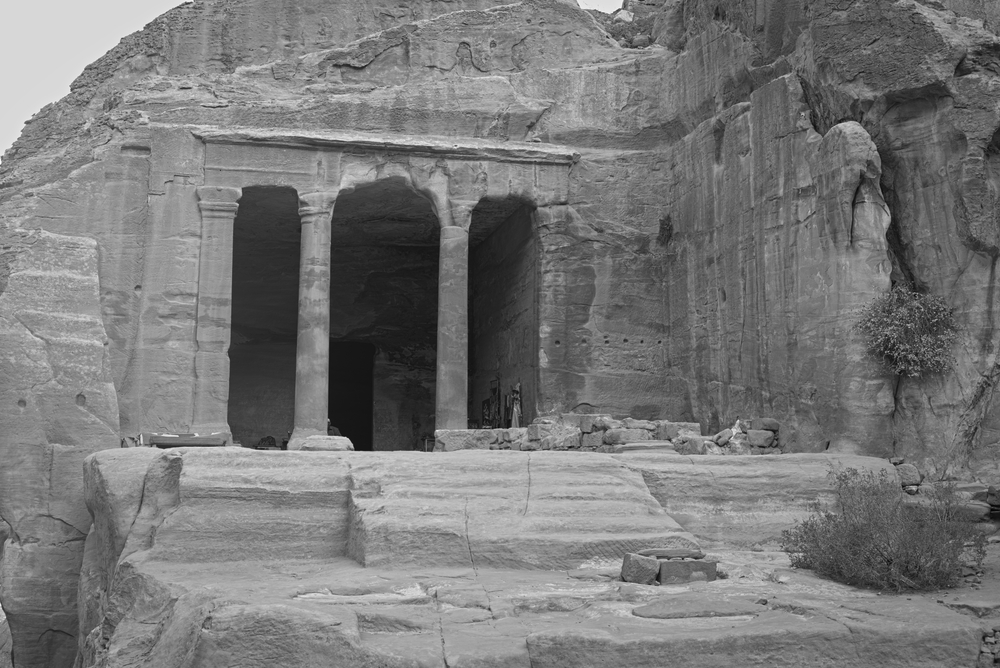
Triclinium
Our host still has a cave, but he only sleeps there when his wife is angry. Like most of the people, he maintains a second home in the village.
It was still quiet away from the main trail. Our route, while arduous, attracted fewer people. Our new friend told us that not many people made it out this way, although traffic does pick up as the day progresses.
It was time for us to progress. At a couple of points we decided to leave the trail and poke our noses up a couple of canyons. We discovered several amazing sandstone structures, which offered wonderful photographic opportunities.
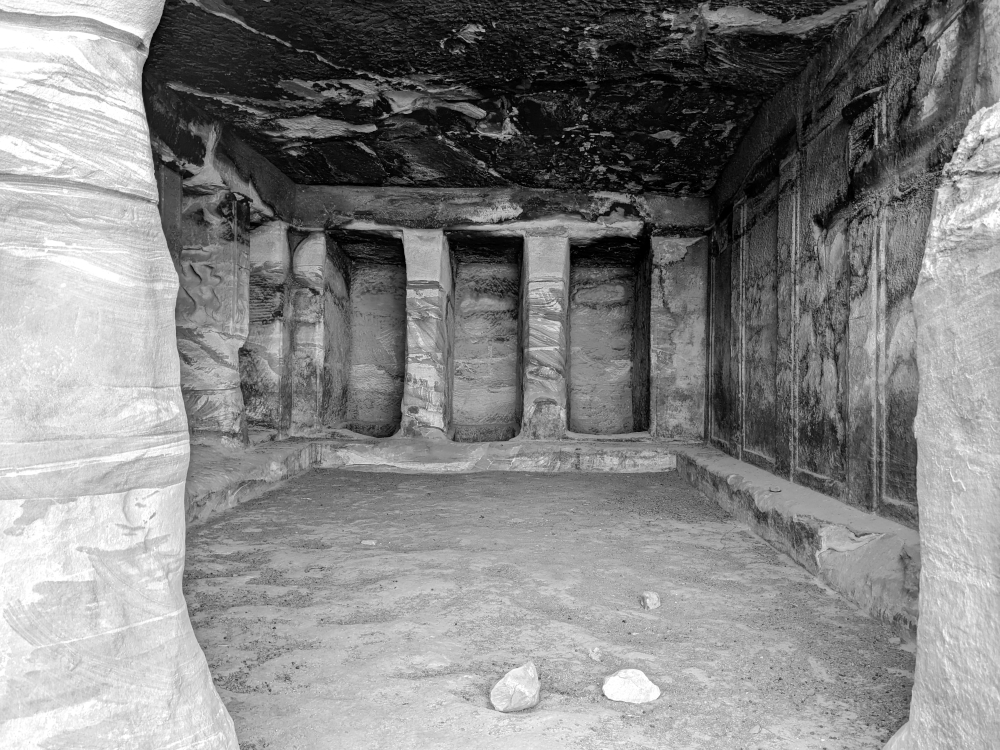
A room, carved into the sandstone
Rooms, carved into the sandstone and adorned with columns and capitals, stood empty, filled only with the lingering smell of goat manure.
We worked our way back around the hills and emerged in the center of Petra, beside the Grand Temple. Showing the influence of contact with Greco-Roman peoples, the Grand Temple resembles the temples found along the northern rim of the Mediterranean.
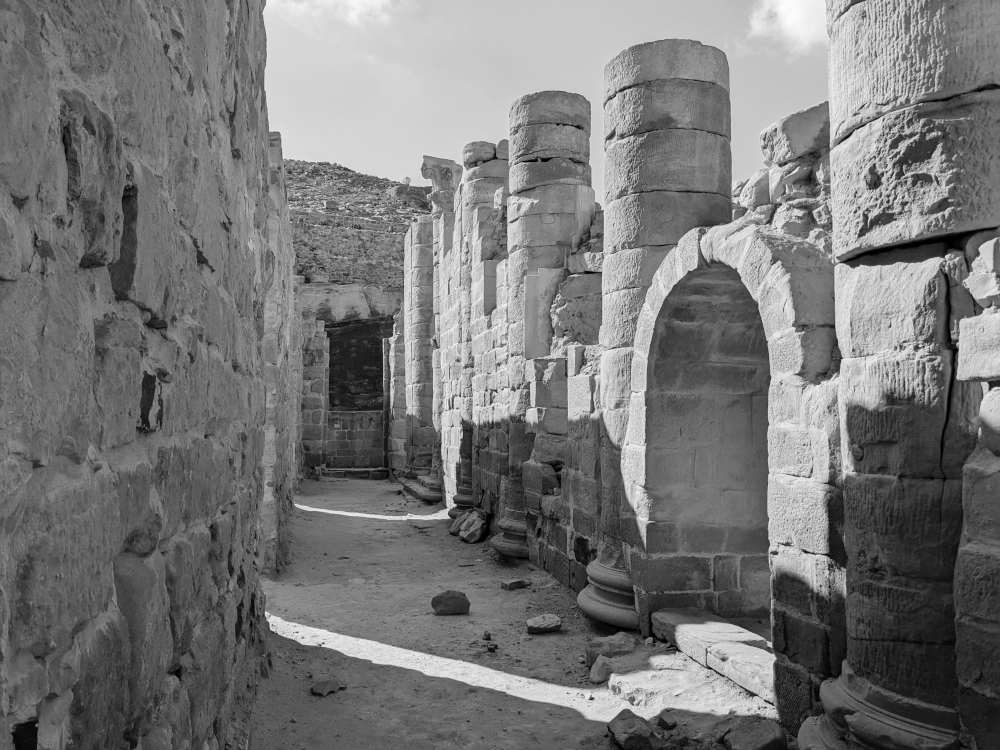
Among the stones of the Grand Temple
After a quick break, we set off on our third route—the Ad-Deir (Monastery) Trail. This was not nearly as pleasant as our first two hikes: the crowds had arrived and the narrow path up the side of a mountain offered numerous traffic jams.
The trail ascends along a rugged canyon, made easier by steps carved into the stone. It was a hard climb, made more difficult by fatigue and the donkey drivers who ran their hapless beasts up and down these stairs. It is possible, for ten dinar (about $15) to ride up the mountainside on the back of the donkey.
This is problematic on several levels. First the drivers feel they have right-of-way, and so are continuously shoving the hikers to the side of the path each time they pass. This is not so bad when the donkeys are groaning slowly up the mountain, but they come down at a brisk lope, hooves clattering against the hard stone and the drivers shouting “Look out! Clear the path!” as the out-of-control animals fly past.
Personally, I think it is abusive. I can’t imagine that these poor animals, laboring beneath well-fed tourists, have much of a life expectancy. Of course the donkeys exact a bit of revenge by leaving fecal piles up and down the route, giving those of us who are hiking something else to keep an eye on.
I was pleased when we crested the last part of the hill and walked out onto the flat spot before the “Monastery.”
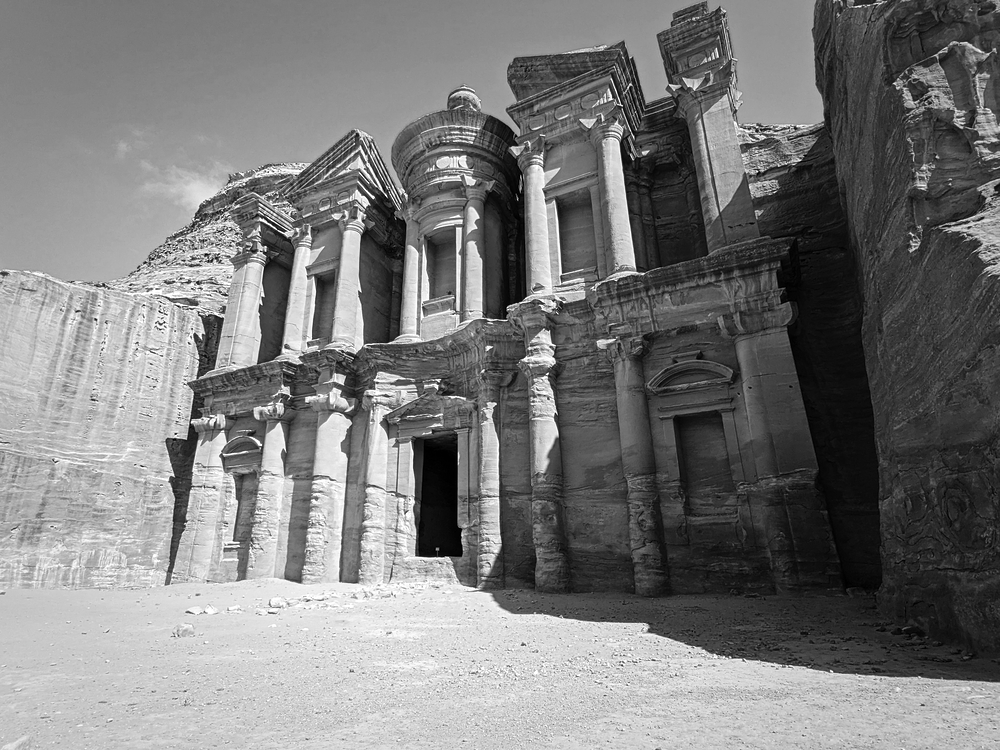
The “Monastery”
Like the “Treasury,” this is a poorly-named place. It was never a monastery. There is a small chapel once used by Christians inside the carved sandstone, but neither monks nor nuns have ever made this their home.
The Monastery was our last major site of the day. We still faced a long descent to the center of Petra, and then a 2.5 mile slog uphill to the visitor center. It was a full day of hiking and standing in awe of what was created in this place.
I am often underwhelmed by “must see” sites, but Petra does not disappoint. It is everything you have heard and more. The Nabataeans created one of the greatest places in the world here.
We really should talk about them more.
If you are enjoying this series, why not subscribe to Richard's monthly newsletter, What's New in Old News? The Peripatetic Historian is on the road, roaming the world and compiling fresh adventures. Don't miss out. Click here to join the legions of above-average readers who have already subscribed.